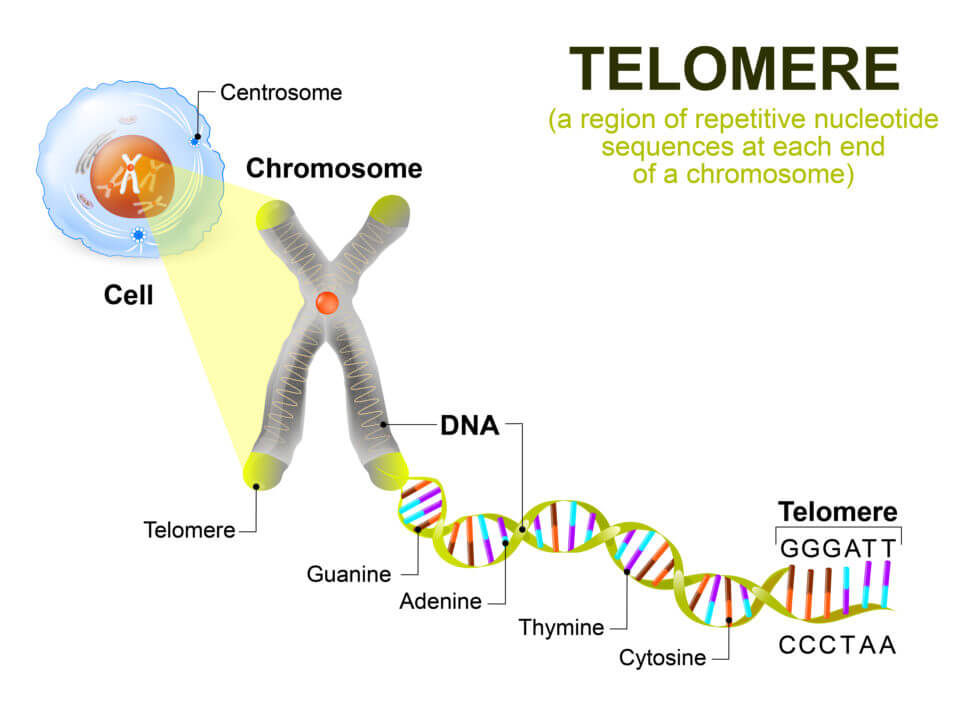Telomere Testing: What’s The Best Anti-Aging Scorecard?
Why not measure telomeres as markers for aging?
| | Reading Time: 7 minutes

Every day, doctors use laboratory tests for cholesterol and LDL levels, along with hundreds of other makers, to diagnosis disease and evaluate risk for illness. Why not measure telomeres as markers for aging? Or rather, anti-aging?
Are Telomere Tests the Anti-Aging Scorecard?
Dr. Mark Tager approached the stage at the American Academy of Anti-Aging Medicine world congress held in Hollywood, Florida, He paused for less than a second, then launched his talk with all engines full throttle. Dr. Tager has a medical degree from Duke University, but later went west where he trained in family medicine at the University of Oregon. Now, he lives in the San Diego area where he heads a consulting company for grumpy, stressed out, unhappy doctors.
The Wharton Healthcare Management Alumni Association refers to Dr. Tager as an agent of change. I can see why. He knows how to grab an audience and get them on his side in the first seven seconds. Standing in front of a group of three hundred medical doctors he came across as critical of anti-aging medicine, not because he’s against it – in fact, he’s all for it – but because he wants doctors to use laboratory markers to prove they have truly anti-aged their patient.
I agree. We need an anti-aging scorecard.
A Quick Review of Telomere Science
The telomere theory of aging has become the dominant scientific explanation of why we age and how we become more prone to chronic diseases during aging. Telomere research is advancing fast and furiously. There are currently more than 20,000 scientific articles listed on PubMed, the online Library of Medicine of the National Institutes of Health.
Telomeres are the caps that protect the tips of chromosomes when cells divide, which they do continuously throughout life. But with each cell division, telomeres get shorter and shorter. The problem is that shortened telomeres are associated with premature aging and are also found in many chronic illnesses, especially in cardiovascular disease.
Telomeres are like the biological clock of aging. The shorter they become, time runs out and the faster we age. But, everyone’s telomeres do no shorten at the same rate. Interestingly, women preserve telomere length longer than men.
The Basics of Telomere Science
Let’s start from the beginning. Base pairs are the building blocks of DNA or RNA.

In my book, Prolonging Health (2003), I helped pioneer the concept of modifiable factors of aging. The idea was to identify specific biological aspects of aging and modify them to slow or reverse the aging process. If you’d like to learn more, I devoted an entire chapter on cell repair.
The Aging Cell
We start life off with about 15,000 base pairs. Yet, scientists discovered that we gradually lose them over our lifetime.
As we age, we lose 20-40 base pairs every year. When we have fewer than 3,000-5,000 base pairs, our genes have difficulty maintaining our bodily process. If we cross the critical telomere threshold, we age faster and develop degenerative conditions like coronary artery disease, diabetes, Parkinson’s, cancer, and get more infections. Interestingly, those with the shortest telomeres have three times the risk of dying from a heart attack compared to older people with longer telomeres.
What’s the Critical Telomere Threshold?
The critical telomere threshold is the number of telomeres necessary to support life. Below that we age faster and are more susceptible to heart disease, diabetes, and cancer.
“We start life off with about 15,000 base pairs. Scientists discovered that we gradually lose them over our lifetime.”
And, that’s what researchers are trying to find out. Professor Duncan Baird of the University of Cardiff discovered that there is a critical shortest length that telomeres can reach before becoming dysfunctional. Exposures to toxic chemicals in the environment and excessive oxidation of cells by free radical molecules (like from overeating animal and dairy fat) have a negative impact on telomeres. But, age plays the dominant role at when we arrive at the critical telomere threshold.
By the time we’re 80 years old, we only have about 1,500 base pairs left. Our DNA can no longer sustain life. Therefore, our muscles atrophy and our bones become weak and porous. Muscle aging, called sarcopenia, degrades all other body systems. We also lose the ability to hear and eyesight dims. We can’t see clearly. Our immune functions falter and develop fatal flaws leaving us more vulnerable to deadly infections. For older people, even seasonal influenza can be fatal.

Why is Telomere Testing Useful?
Based on the current research, it seems logical that determining the length of our telomeres earlier is the most consistent scientific way to know how well we are aging or anti-aging. Knowing our telomere length is an incentive to engage in anti-aging practices including regular exercise, eating a plant-based diet, and taking nutritional supplements and adaptogenic herbs.
Because telomere length and rate of telomere shortening serve as indicators of a cell’s age, lab tests for telomere health are becoming an integral part of the comprehensive wellness and anti-aging evaluation. Telomere shortness has become an indicator of disease risk and severity of progression, and for accelerated aging. Growing longer telomeres is a measure of a successful wellness and anti-aging program.
The ability to monitor telomere length and assess the number of critically short telomeres is an essential biomarker in your anti-aging toolkit. For now, a doctor has to order telomere tests. But, soon you’ll be able to hack into anti-aging techniques, including telomere testing on your own.
The Benefits of Three Telomere Tests
There are three different ways to test the length of your telomeres. What is the best one for you?
The most common way to measure telomere length is from white blood cells. Telomere length tested from white blood cells, technically called leukocytes, is a good general representation of medium telomere length. However, leukocyte telomere length does not quantify the number of critically short telomeres per cell. Without knowing the amount of critically short telomeres, you cannot get a precise idea of how well or how poorly you are aging.
- Life Length, based in Madrid, Spain with North American representation by AML Diagnostics in Florida and ClevelandHeartLab, employs a technology called Q-TRAP that measures telomerase and TAT (telomere analysis technology) to access telomere length by high-content screening using fluorescence technology. This method provides a comprehensive analysis of the entire distribution of telomere length ranging from the shortest to the longest telomeres. Life Length’s technology is a highly accurate assessment tool for telomere length.
- Telomere Diagnostics, located in the San Francisco Bay area, uses cutting-edge quantitative polymerase chain reaction technology to analyze white blood cell telomeres. It is an accurate test providing an average telomere length. Teloyears is the home test, finger prick blood test offered by Telomere Diagnostics.
- SpectraCell Laboratories produced the first commercial test for telomere length in the United States. SpectraCell’s telomere test determines telomere length about a person’s age taken from a white blood cell sample. Telomere length is determined using a ratio of the genetic material in a white blood cell telomere to calculate an approximate telomere score. This score is compared to a population of people with similar chronological age. SpectraCell provides an affordable test, but it is not a direct measurement of telomere length or biological age.
These are not the only companies that measure telomeres, but they are the most respected by doctors.
Test for Critically Short Telomeres
All three labs are FDA approved. All three are valuable and reliable. However, for my patients, I use Life Length telomere testing because of results are accurate and dependable. Life Length advanced technology measures both telomere length distribution and critically short telomeres. The number of critically short telomeres plays a vital role in age-related chronic diseases.
 I believe that everyone should have baseline telomere testing during their peak reproductive years between 18-28, including hormones and telomeres. Comprehensive testing is best done again between 45-55 to establish the hormone levels and the number of shortening telomeres. Re-test when you are 65 or older. The lower your hormone levels and the shorter your telomeres, the faster you’ll age and the higher your risk for chronic disease.
I believe that everyone should have baseline telomere testing during their peak reproductive years between 18-28, including hormones and telomeres. Comprehensive testing is best done again between 45-55 to establish the hormone levels and the number of shortening telomeres. Re-test when you are 65 or older. The lower your hormone levels and the shorter your telomeres, the faster you’ll age and the higher your risk for chronic disease.
Grow Your Telomeres Longer
A study by Dean Ornish published in 2008 in Lancet Oncology showed that comprehensive lifestyle changes made a significant improvement in telomere length and telomere activity. Additionally, the information from the Ornish study demonstrates that a healthy diet and exercise enhance telomerase concentrations in healthy cells. It confirms what other researchers have already shown: telomere length can be manipulated.
The key to lengthening telomeres is in activating telomerase, the enzyme responsible for healthy telomeres. Telomerase not only preserves telomere length but also promotes healthy cell function and supports immunity. A disease-free, lifelong health is associated with longer telomeres.
Fortunately, you can tweak your telomere length for the better with a plant-based diet, regular exercise, stress reduction, antioxidant supplements, and adaptogenic herbs like Astragalus extract. The best-studied method is by taking geroprotectants, anti-aging molecule regulators like resveratrol found in red wine.
Geroprotectants include an extract from the traditional Chinese herbal medicine Astragalus called TA-65. Other geroprotectants include melatonin, metformin, rapamycin, and glutathione. Exercise has been shown to lengthen telomeres. And, plant-based diets also promote healthy telomerase active and keep telomeres long.
12 Ways to Promote Longer Telomeres:
- Consume a chemical-free, non-GMO, plant-based diet
- Eat less meat, and consume less animal and dairy fat
- Consume 10-30% fewer calories
- Stop smoking
- Take melatonin
- Use resveratrol supplements
- Take specialized Astragalus extracts like TA65
- Use 5-MTHF (5-methyltetrahydrofolate), the active form of folic acid
- Exercise regularly, including yoga, and practice meditation
- Lower stress
- Include the “basic six” supplements: Vitamin B12, C, D, E, zinc, and omega-3 fatty acids
- Keep your testosterone and estrogen levels strong during aging
The Bottom Line
It’s encouraging to know that we can control our cellular processes through diet and lifestyle. It’s beneficial to realize that adopting a healthy way of life supported with nutritional supplements helps lengthen telomeres and prevents age-related diseases.
Telomere science, no matter how sophisticated, is but one of many doors in the mansion of the biology of aging. Step through, and get your telomeres tested, but keep going. Life is a long journey but is over far too soon to delay decisive action now.
By laboratory telomere testing, you can tell how well you’re aging and almost predict how long you might live. The next time someone asks how is your anti-aging program going, just show them your telomere scorecard. The longer, the better.


